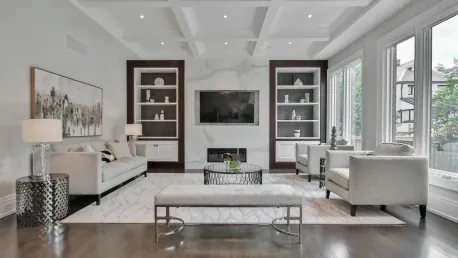Designing a living room that balances functionality with style requires careful planning and attention to detail. Achieving a space that is both comfortable and visually appealing involves understanding key principles of furniture spacing and placement. Through this guide, insights from expert designers reveal essential tips for creating a living area that not only looks great but also enhances daily living and entertaining.
Optimal Spacing Between Major Furniture
Understanding the importance of adequate spacing between major furniture pieces is essential for a functional living room. Experts recommend leaving about 30 to 36 inches between large pieces of furniture. This distance facilitates easy movement and maintains a balanced flow throughout the room, ensuring that every area remains accessible without feeling overly cluttered. In tighter spaces, this spacing can be reduced to a minimum of 24 inches, though it is vital to avoid making the room feel cramped.
Leaving appropriate space not only ensures comfort but also enhances the overall flow of the room. Striking the right balance between openness and coziness is key for creating an inviting living area that encourages relaxation and socialization. By adhering to these spacing guidelines, the living room can achieve a harmonious layout that merges practicality with aesthetic appeal.
Proper Couch Placement
Another crucial aspect of living room design is the correct placement of the couch. Placing the couch right against the wall is generally discouraged. Instead, leaving a 3 to 5 inch gap between the sofa and the wall can greatly enhance the room’s ambiance. This small buffer improves airflow, protects both walls and upholstery from damage, and prevents the room from feeling too packed.
This subtle adjustment can make a significant difference in both the comfort and refinement of the living space. By allowing even a small amount of breathing room behind the couch, the overall environment becomes more open and breathable. This practice contributes to a more inviting and relaxed atmosphere, making the living room a more enjoyable place to spend time.
Ideal Coffee Table and Side Table Distances
The positioning of coffee tables and side tables is another key element in creating a functional and well-organized living room. Experts recommend placing the coffee table approximately 14 to 18 inches away from the couch. This distance provides enough space for easy access to items on the table while still allowing for comfortable legroom. Maintaining this range ensures that the living room remains practical and prevents it from feeling overcrowded.
For side tables, a closer proximity to the sofa is generally acceptable. Placing side tables within 2 to 4 inches of the sofa allows for convenient access without crowding the seating area. The height of the side table should ideally be close to the height of the sofa arm, within 2 inches, to create a balanced and cohesive look. This thoughtful placement enhances both the functionality and visual harmony of the living room.
TV Placement and Viewing Distance
Television placement is another critical factor in designing a functional living room. It is important to consider both the distance from the couch and the height at which the TV is mounted. For a 55-inch TV, the recommended viewing distance is between 7 to 9 feet, while a 65-inch TV should be placed 8 to 10 feet away from the seating area. These guidelines ensure comfortable viewing and prevent eye strain, allowing for an optimal entertainment experience.
Mounting the TV at the correct height is just as important as the distance. The center of the TV screen should align with eye level when seated, typically 42 to 48 inches from the floor. This positioning helps prevent neck strain and promotes a natural and comfortable viewing experience. By following these guidelines, the living room can become a perfect spot for relaxation and entertainment.
Rug Placement Guidelines
Rug placement plays a significant role in the overall design of a living room. Leaving a border of 12 to 18 inches between the edge of the rug and the walls helps to define the rug as a distinct design element. This spacing also prevents the room from appearing as though it has wall-to-wall carpeting, which can detract from the intended aesthetic.
In smaller living rooms, the border can be slightly reduced while still maintaining an open, balanced, and layered look. This consideration not only contributes to the visual appeal but also ensures that air vents remain unobstructed and furniture is given a clear visual boundary. The aim is to create a pleasing arrangement that enhances the look and feel of the space without compromising on comfort or style.
Lighting and Artwork Placement
Lighting, particularly the placement of pendant lights, requires careful consideration to ensure optimal illumination and adequate headroom. Hanging pendant lights about 7 feet (84 inches) above the floor is recommended. This height allows for sufficient clearance and prevents head bumps while also providing ample lighting for the area. When positioning pendant lights above a table, maintaining a height of 30 to 36 inches above the surface ensures the table is well-lit without obstructing views.
Artwork placement is another vital aspect of living room design. Experts suggest hanging artworks at eye level to avoid the common mistake of placing them too high. This level of placement ensures that the artwork is comfortably visible and contributes positively to the room’s aesthetic. Properly placed artwork can significantly enhance the living room’s overall ambiance and personal touch, making the space truly feel like home.
Creating a Harmonious Living Space
Designing a living room that perfectly marries functionality with style demands careful planning and attention to detail. Creating a space that is both cozy and visually attractive requires grasping the fundamental principles of furniture arrangement and spacing. This guide draws on insights from professional designers to offer valuable tips for crafting a living area that excels in both form and function. Whether you’re aiming to enhance daily living, cater to entertaining guests, or simply achieve an aesthetically pleasing environment, these expert suggestions will help you realize your vision. From selecting the right furniture pieces to strategically placing them for optimal flow and usage, understanding how to balance these elements is crucial. Functional aspects like ease of movement and accessibility should complement stylistic choices, creating a harmonious and inviting space. By incorporating these principles, you can transform your living room into a place that is not only beautiful but also enhances the quality of your everyday life and social gatherings.









